An Efficient 24–30 GHz GaN-on-Si Driver Amplifier Using Synthesized Matching Networks
Abstract
:1. Introduction
2. Circuit Design Considerations
2.1. Fundamental Load-Pull Analysis and Determination of the Optimal Impedance Domain
2.2. Harmonic Load-Pull Analysis and Determination of the Phase Avoidance Interval
3. Design and Implementation of Matching Networks
3.1. Mixed-Element Realization Method and Layout Considerations
3.2. Synthesized Low-Pass OMN and ISMN
3.3. Input Impedance Model and the Synthesized Band-Pass IMN
3.4. Loss Analysis of the MN and Stability of DA
4. Probed Measurement Results
4.1. Small-Signal Characterization
4.2. Large-Signal Characterization
5. Conclusions
Author Contributions
Funding
Institutional Review Board Statement
Informed Consent Statement
Data Availability Statement
Acknowledgments
Conflicts of Interest
References
- Camarchia, V.; Quaglia, R.; Piacibello, A.; Nguyen, D.P.; Wang, H.; Pham, A.V. A review of technologies and design techniques of millimeter-wave power amplifiers. IEEE Trans. Microw. Theory Tech. 2020, 68, 2957–2983. [Google Scholar] [CrossRef]
- Peng, L.; Li, J.; Zhang, G.; Lin, S.; Chen, J. Ka-band GaAs MMIC driver amplifier design. In Proceedings of the 2020 IEEE 3rd International Conference on Electronic Information and Communication Technology (ICEICT), Shenzhen, China, 13–15 November 2020; pp. 287–290. [Google Scholar]
- Li, T.W.; Huang, M.Y.; Wang, H. Millimeter-wave continuous-mode power amplifier for 5G MIMO applications. IEEE Trans. Microw. Theory Tech. 2019, 67, 3088–3098. [Google Scholar] [CrossRef]
- Cripps, S.C. RF Power Amplifiers for Wireless Communications, 2nd ed.; Artech House: Norwood, MA, USA, 2006. [Google Scholar]
- Cripps, S.C.; Tasker, P.J.; Clarke, A.L.; Lees, J.; Benedikt, J. On the continuity of high efficiency modes in linear RF power amplifiers. IEEE Microw. Wirel. Compon. Lett. 2009, 19, 665–667. [Google Scholar] [CrossRef]
- Yarman, B.S.; Carlin, H.J. A simplified “real frequency” technique applied to broad-band multistage microwave amplifiers. IEEE Trans. Microw. Theory Tech. 1982, 30, 2216–2222. [Google Scholar] [CrossRef]
- An, J.; Song, K.; Zhang, S.; Yang, J.; Cao, P. Design of a broadband electrical impedance matching network for piezoelectric ultrasound transducers based on a genetic algorithm. Sensors 2014, 14, 6828–6843. [Google Scholar] [CrossRef] [PubMed] [Green Version]
- Zhang, J.-L.; Wang, H.-Z.; Zheng, Z.-Q.; Zhu, X.-Z. Research of SRFT improving and antenna broadband matching based on the IWO–LM algorithm. IET Microw. Antennas Propag. 2018, 12, 2320–2325. [Google Scholar]
- Matthaei, G.L. Tables of Chebyshev impedance–transforming networks of low-pass filter form. Proc. IEEE 1964, 52, 939–963. [Google Scholar] [CrossRef] [Green Version]
- Dawson, D.E. Closed-form solutions for the design of optimum matching networks. IEEE Trans. Microw. Theory Tech. 2008, 57, 121–129. [Google Scholar] [CrossRef]
- Meng, X.; Yu, C.; Liu, Y.; Wu, Y. Design approach for implementation of class-J broadband power amplifiers using synthesized band-pass and low-pass matching topology. IEEE Trans. Microw. Theory Tech. 2017, 65, 4984–4996. [Google Scholar] [CrossRef]
- Nakatani, K.; Yamaguchi, Y.; Hangai, M.; Shinjo, S. A Ka-band CW 15.5 W 15.6% fractional bandwidth GaN power amplifier MMIC using wideband BPF inter-stage matching network. In Proceedings of the 2019 IEEE BiCMOS and Compound Semiconductor Integrated Circuits and Technology Symposium (BCICTS), Nashville, TN, USA, 3–6 November 2019; pp. 1–4. [Google Scholar]
- Chen, K.; Peroulis, D. Design of highly efficient broadband class-E power amplifier using synthesized low-pass matching networks. IEEE Trans. Microw. Theory Tech. 2011, 59, 3162–3173. [Google Scholar] [CrossRef]
- Saad, P.; Fager, C.; Cao, H.; Zirath, H.; Andersson, K. Design of a highly efficient 2–4-GHz octave bandwidth GaN-HEMT power amplifier. IEEE Trans. Microw. Theory Tech. 2010, 58, 1677–1685. [Google Scholar] [CrossRef]
- Feuerschütz, P.; Friesicke, C.; Quay, R.; Jacob, A.F. A Q-band power amplifier MMIC using 100 nm AlGaN/GaN HEMT. In Proceedings of the 2016 11th European Microwave Integrated Circuits Conference (EuMIC), London, UK, 3–4 October 2016; pp. 305–308. [Google Scholar]
- Yang, M.; Xia, J.; Guo, Y.; Zhu, A. Highly efficient broadband continuous inverse class-F power amplifier design using modified elliptic low-pass filtering matching network. IEEE Trans. Microw. Theory Tech. 2016, 64, 1515–1525. [Google Scholar] [CrossRef] [Green Version]
- Peng, L.; Chen, J.; Zhang, Z.; Huang, Y.; Wang, T.; Zhang, G. Design of broadband high-gain GaN MMIC power amplifier based on reactive/resistive matching and feedback technique. IEICE Electron. Express 2021, 18, 20210313. [Google Scholar] [CrossRef]
- Neininger, P.; John, L.; Brückner, P.; Friesicke, C.; Quay, R.; Zwick, T. Design, analysis and evaluation of a broadband high-power amplifier for Ka-band frequencies. In Proceedings of the 2019 IEEE MTT-S International Microwave Symposium (IMS), Boston, MA, USA, 2–7 June 2019; pp. 564–567. [Google Scholar]
- Chen, S.; Nayak, S.; Campbell, C.; Reese, E. High efficiency 5W/10W 32-38GHz power amplifier MMICs utilizing advanced 0.15 µm GaN HEMT technology. In Proceedings of the 2016 IEEE Compound Semiconductor Integrated Circuit Symposium (CSICS), Austin, TX, USA, 23–26 October 2016; pp. 1–4. [Google Scholar]
- Tong, X.; Zhang, S.; Zheng, P.; Xu, J.; Wang, R. 23.5–30 GHz gallium nitride on silicon power amplifier MMIC with 7.6–12.4 W saturation output power. Microw. Opt. Technol. Lett. 2019, 61, 1797–1801. [Google Scholar] [CrossRef]
- OMMIC. U-GaN Design Manual v1.3.1; OMMIC: Limeil-Brévannes, France, 2020. [Google Scholar]
- Moron, J.; Leblanc, R.; Lecourt, F.; Frijlink, P. 12W, 30% PAE, 40 GHz power amplifier MMIC using a commercially available GaN/Si process. In Proceedings of the 2018 IEEE/MTT-S International Microwave Symposium-IMS, Philadelphia, PA, USA, 10–15 June 2018; pp. 1457–1460. [Google Scholar]
- Lee, W.; Kang, H.; Lee, H.; Lim, W.; Bae, J.; Koo, H.; Yoon, J.; Hwang, K.C.; Lee, K.Y.; Yang, Y. Broadband InGaP/GaAs HBT power amplifier integrated circuit using cascode structure and optimized shunt inductor. IEEE Trans. Microw. Theory Tech. 2019, 67, 5090–5100. [Google Scholar] [CrossRef]
- Tu, Z.; Li, B.; Shang, Y.; Wang, Z.; Wang, L.; Liu, D.; Zhou, M.; Huang, Z.; Yu, F. High-efficiency K-band MMIC power amplifier using multi-harmonic load terminations. Microelectron. J. 2015, 46, 1453–1458. [Google Scholar] [CrossRef]
- Yarman, B.S.; Aksen, A. An integrated design tool to construct lossless matching networks with mixed lumped and distributed elements. IEEE Trans. Circuits Syst. I Fundam. Theory Appl. 1992, 39, 713–723. [Google Scholar] [CrossRef]
- Rubio, J.J.M.; Quaglia, R.; Piacibello, A.; Camarchia, V.; Tasker, P.J.; Cripps, S. 3–20-GHz GaN MMIC Power Amplifier Design Through a COUT Compensation Strategy. IEEE Microw. Wirel. Compon. Lett. 2021, 31, 469–472. [Google Scholar] [CrossRef]
- Ardekani, M.H.M.; Abiri, H. A new approach to design wide band power amplifiers by compensating parasitic elements of transistors. AEU-Int. J. Electron. Commun. 2018, 92, 1–7. [Google Scholar] [CrossRef]
- Dennler, P. Analysis of the Potential of Gallium Nitride Based Monolithic Power Amplifiers in the Microwave Domain with More than an Octave Bandwidth. Ph.D. Thesis, Albert-Ludwigs-Universität Freiburg, Breisgau, Germany, 2014. [Google Scholar]
- Qorvo. High Frequency Amplifiers, TGA2594 Data Sheet. Available online: http://www.qorvo.com (accessed on 11 November 2022).

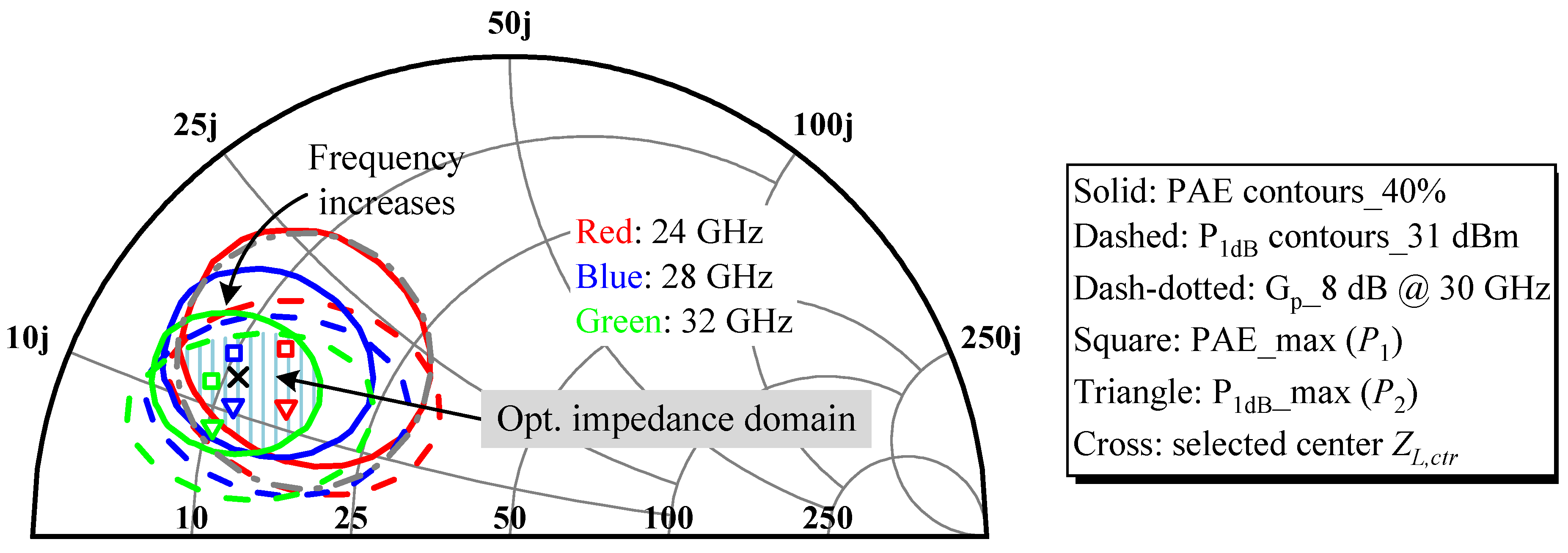
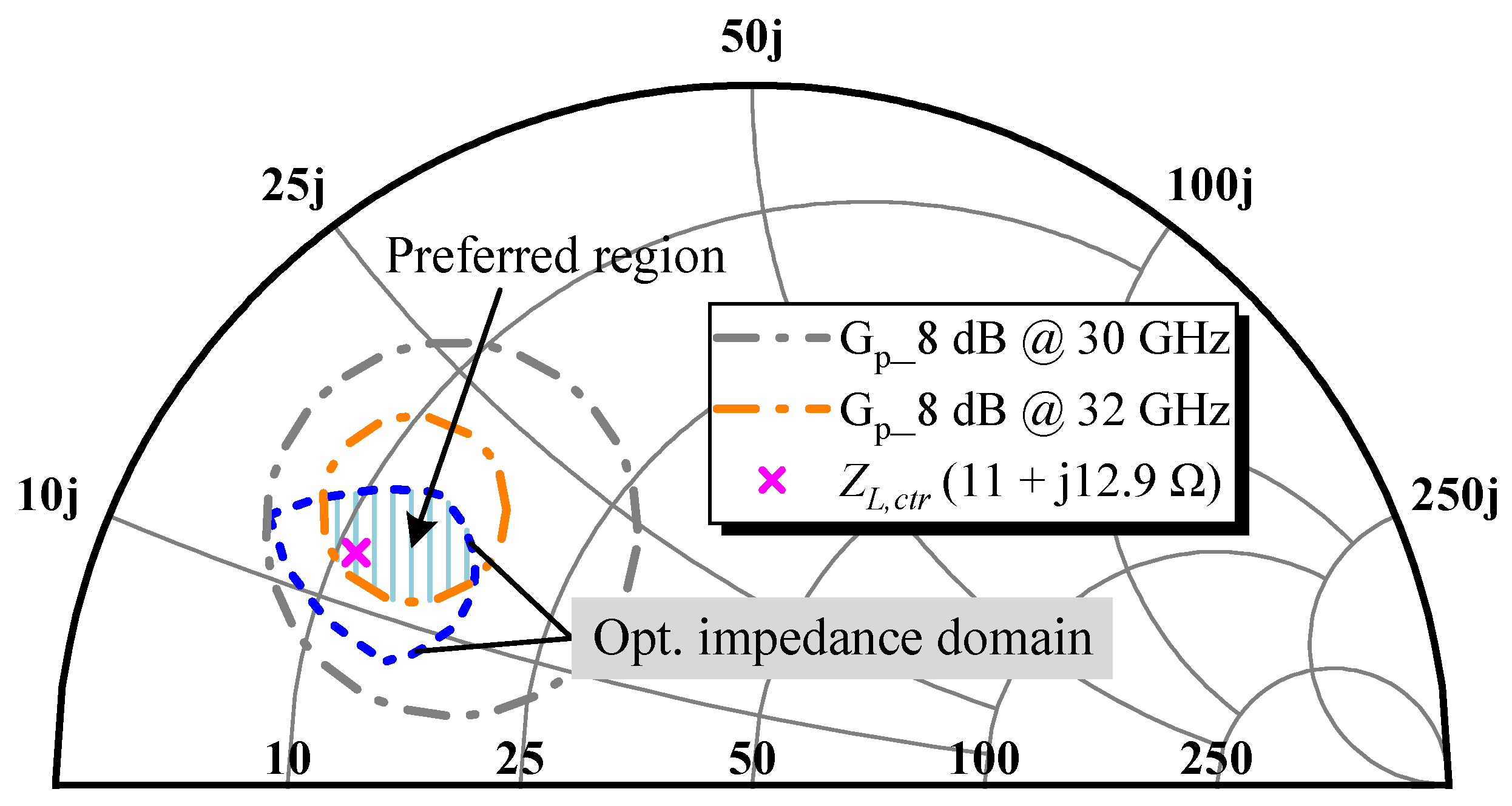

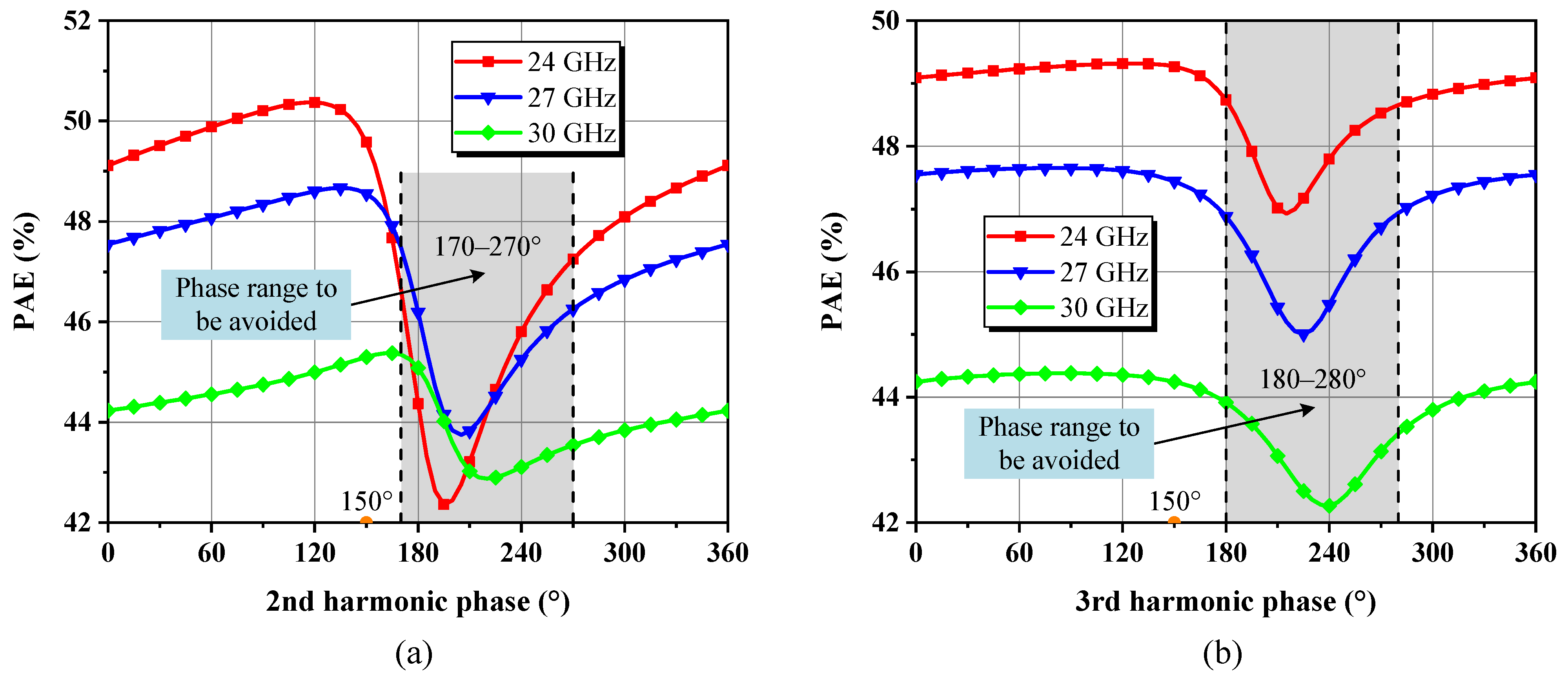
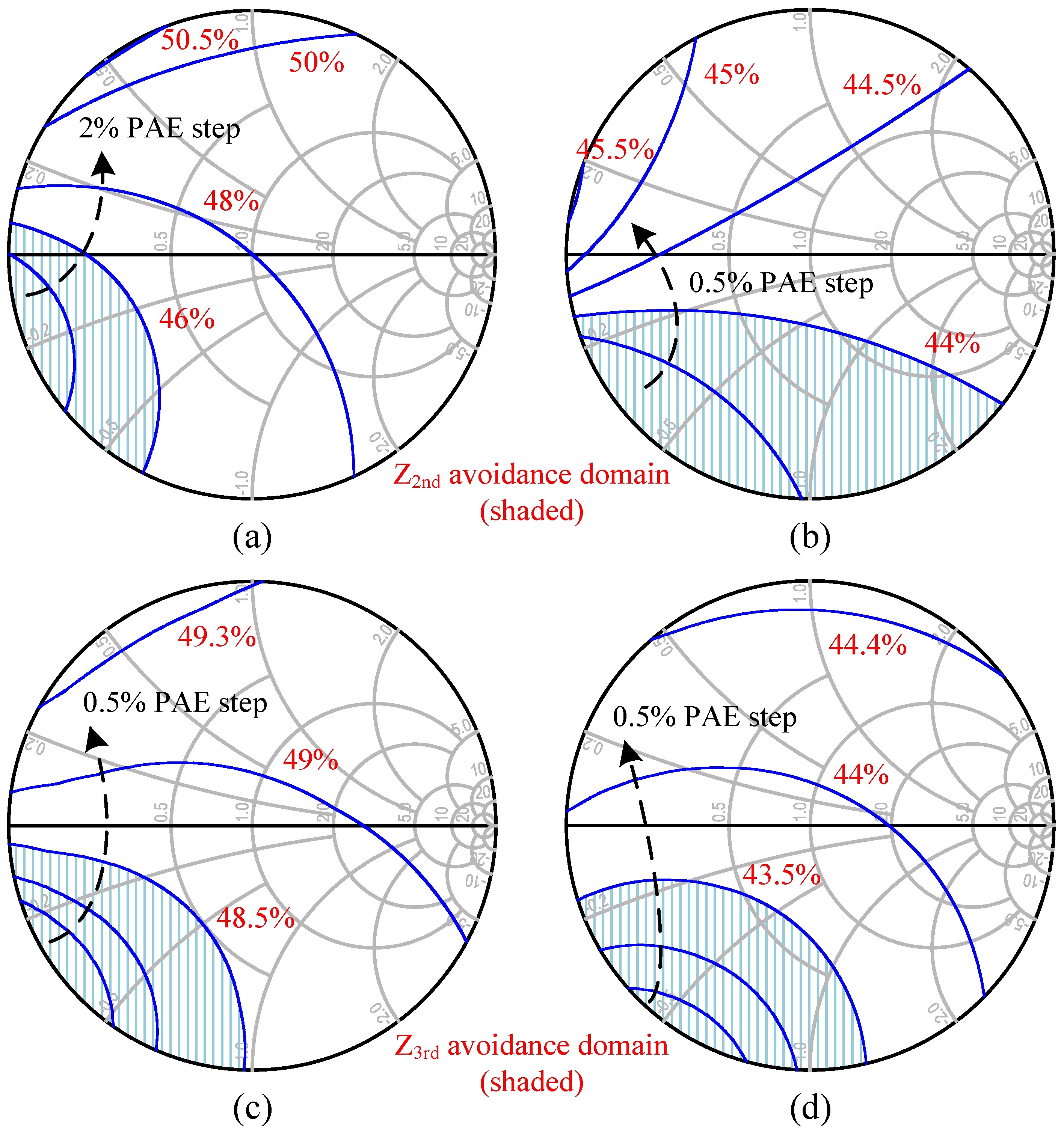

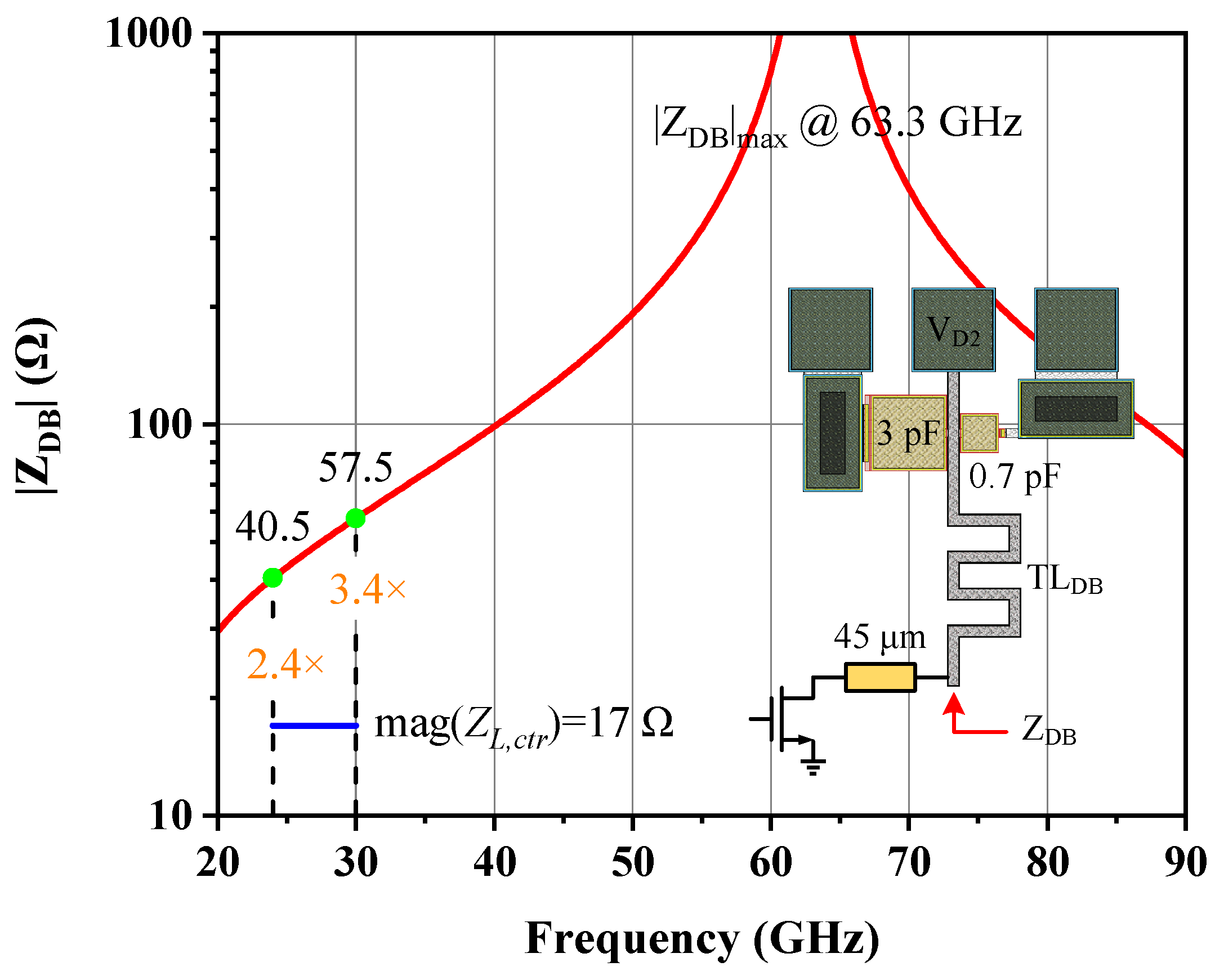

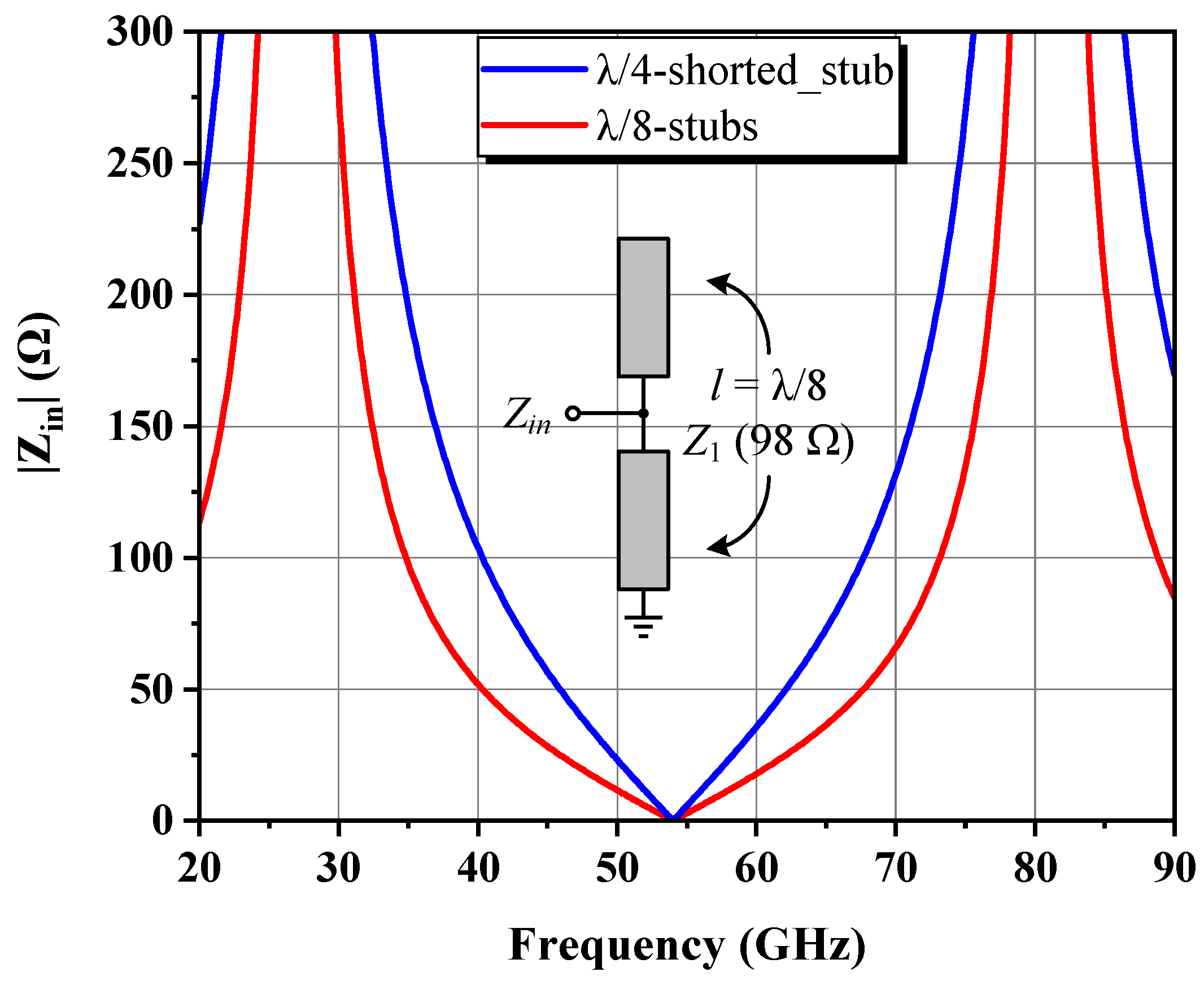

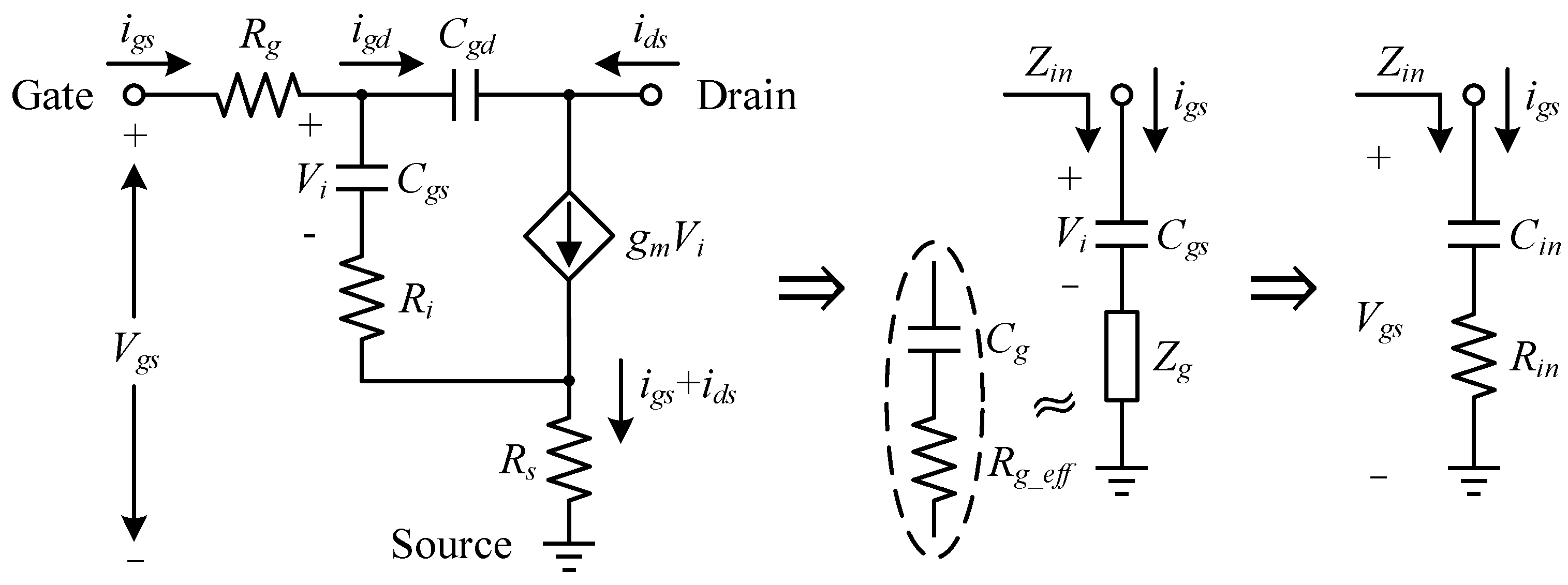
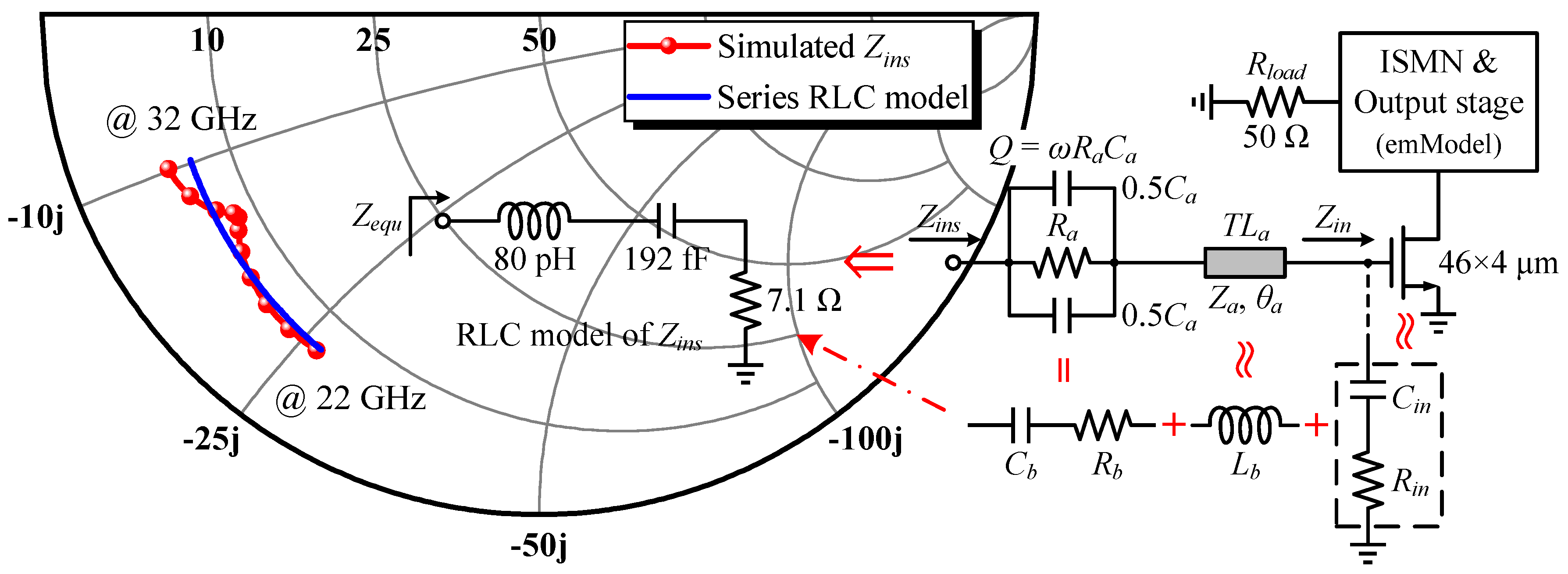
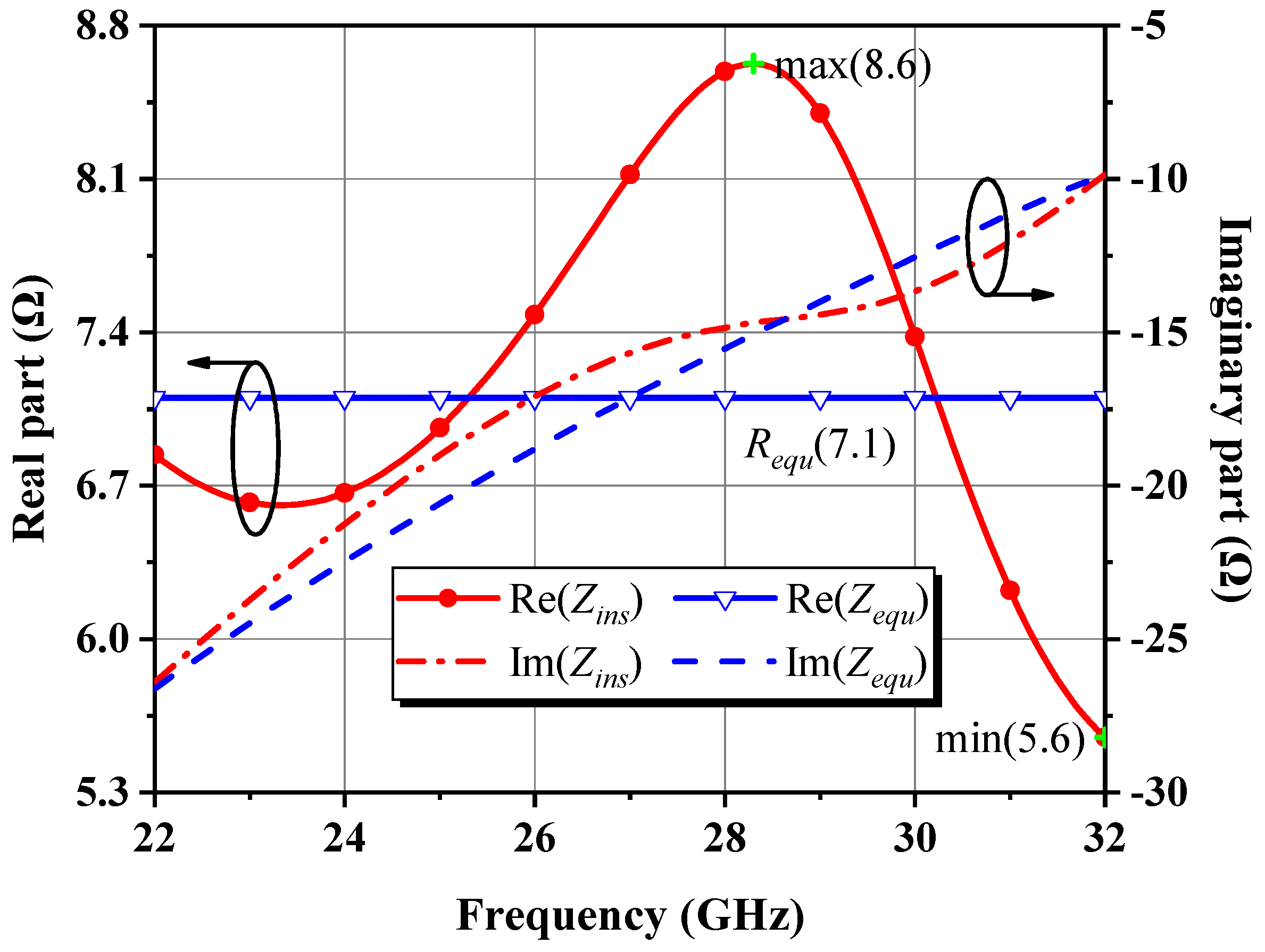
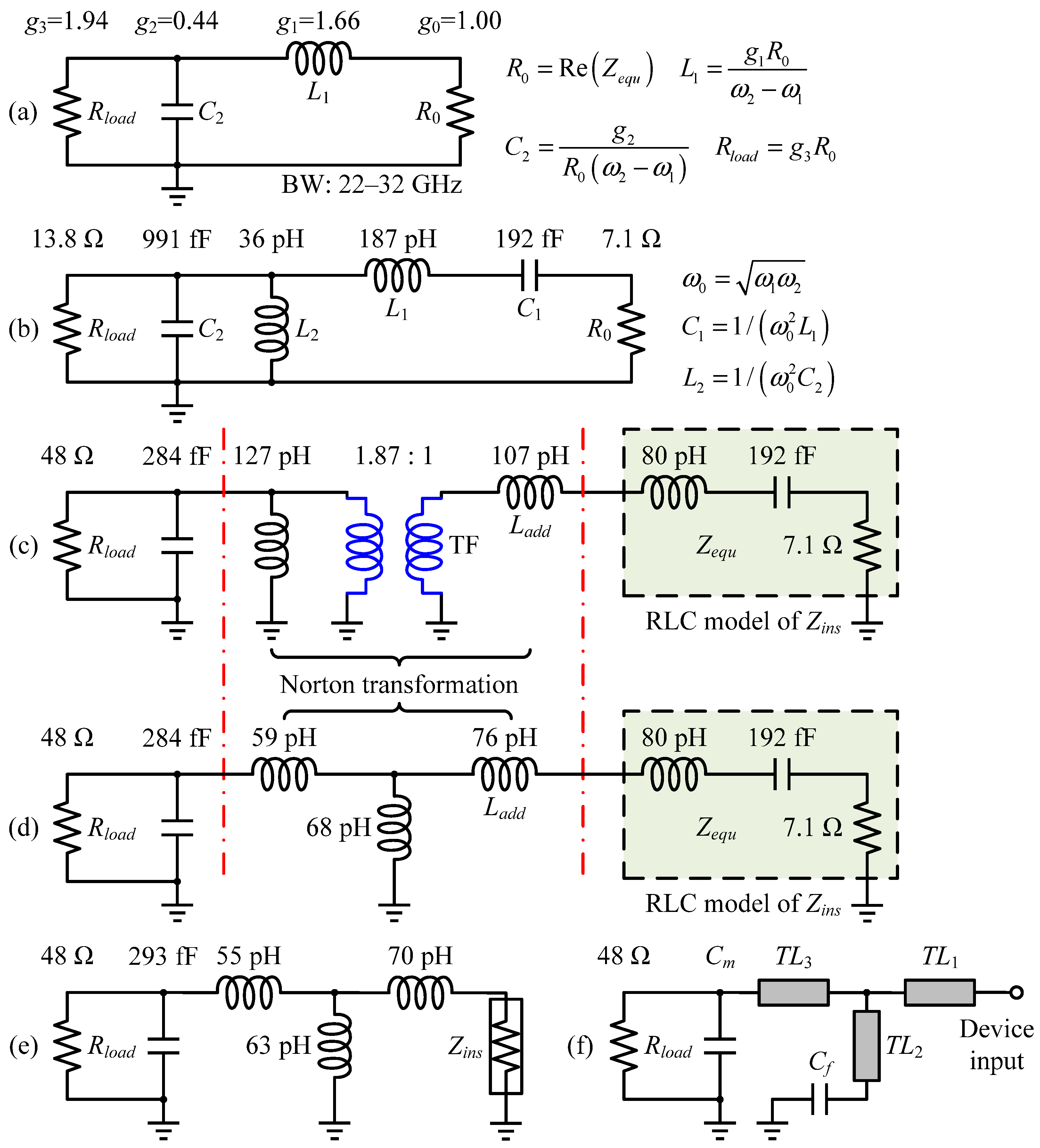
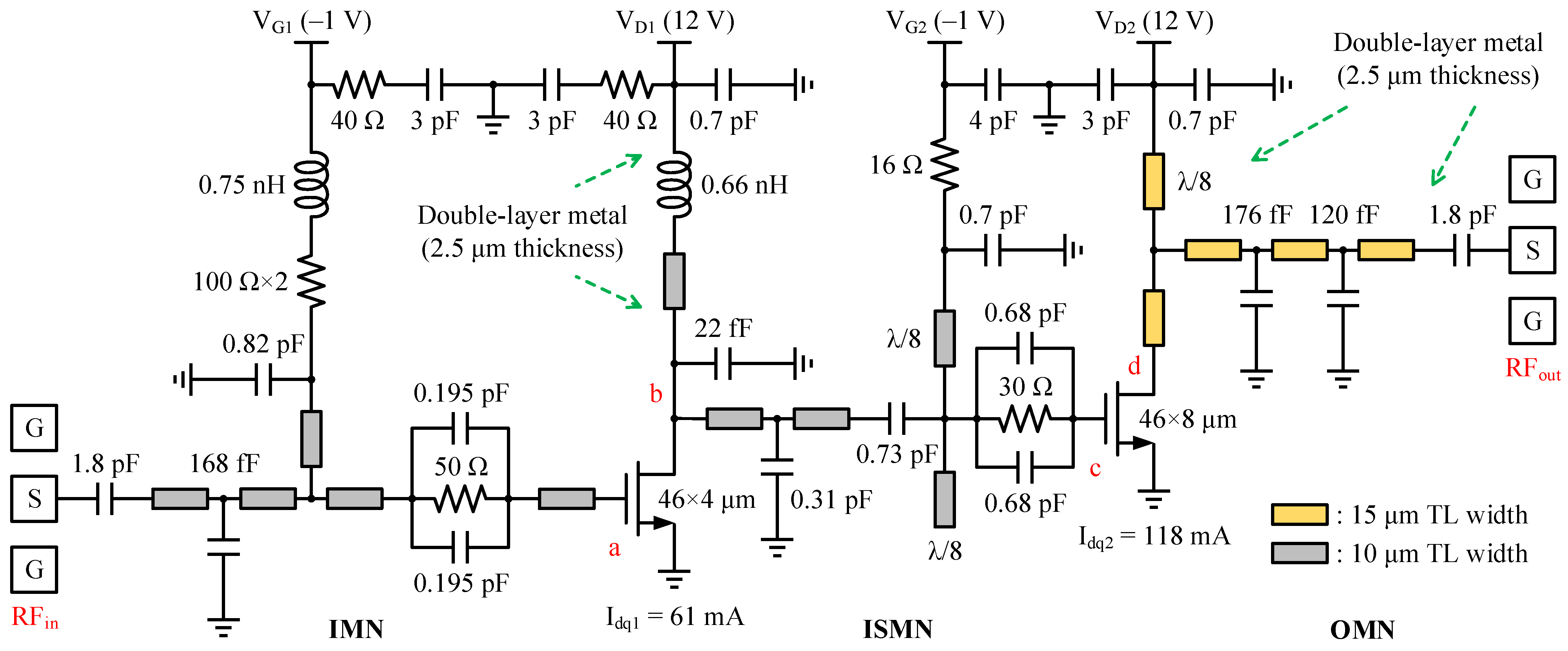
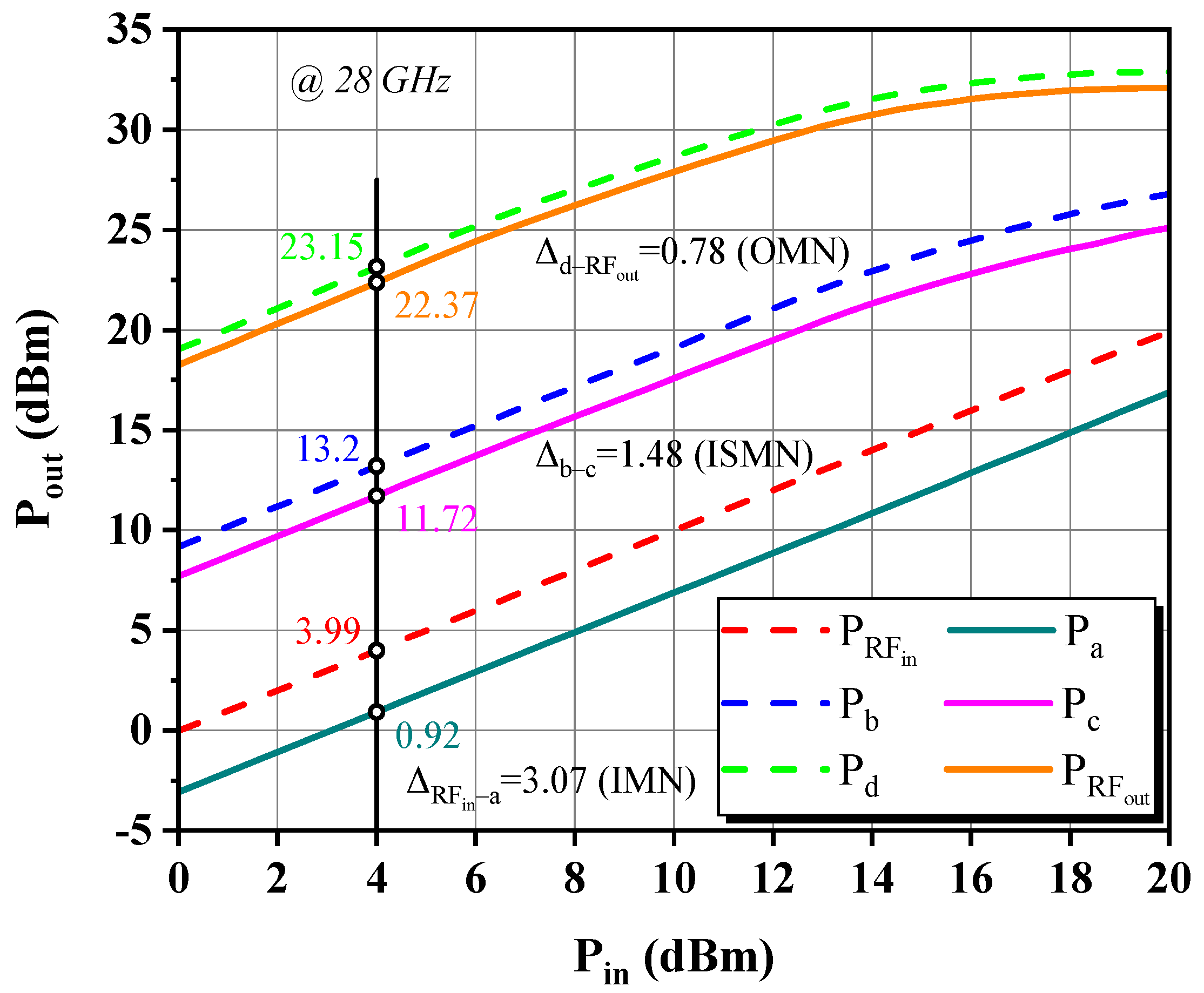


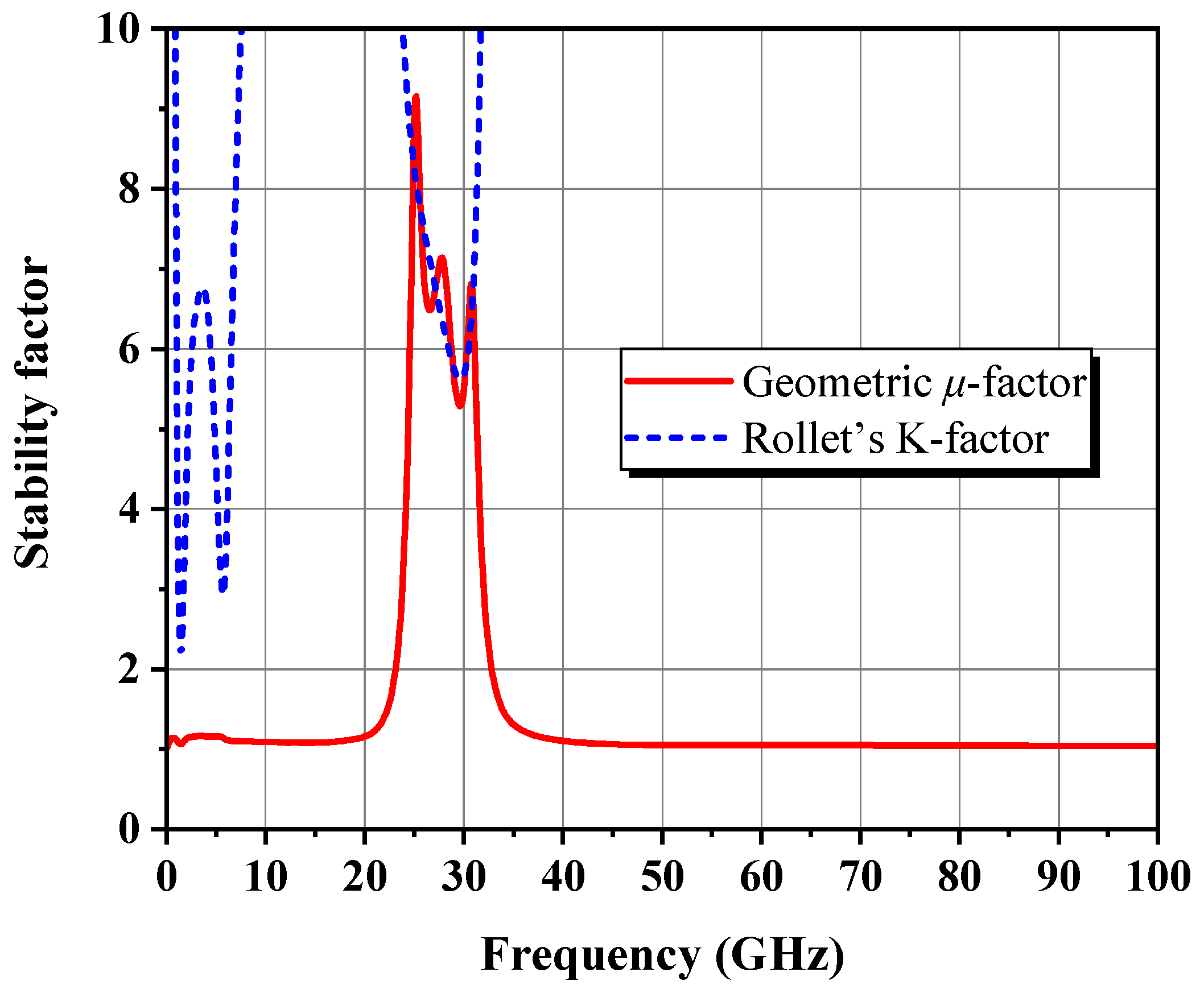
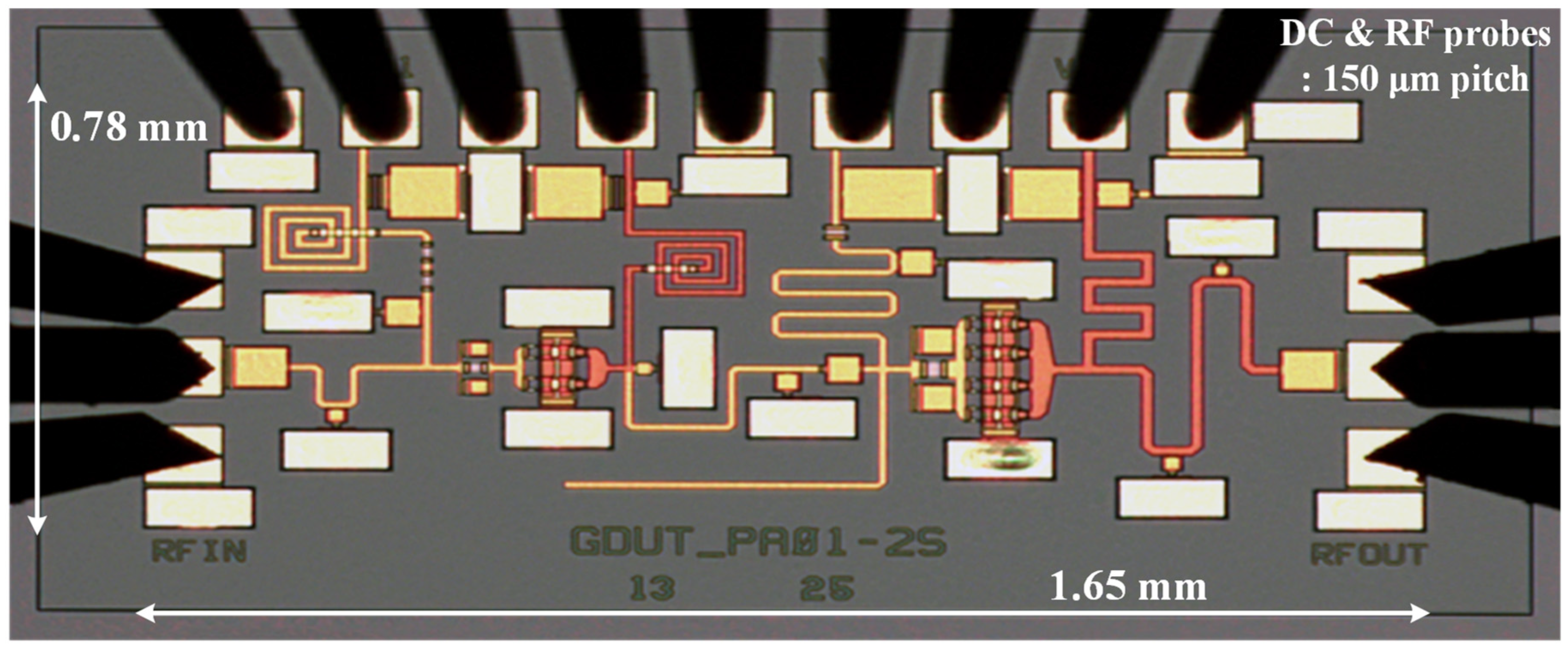
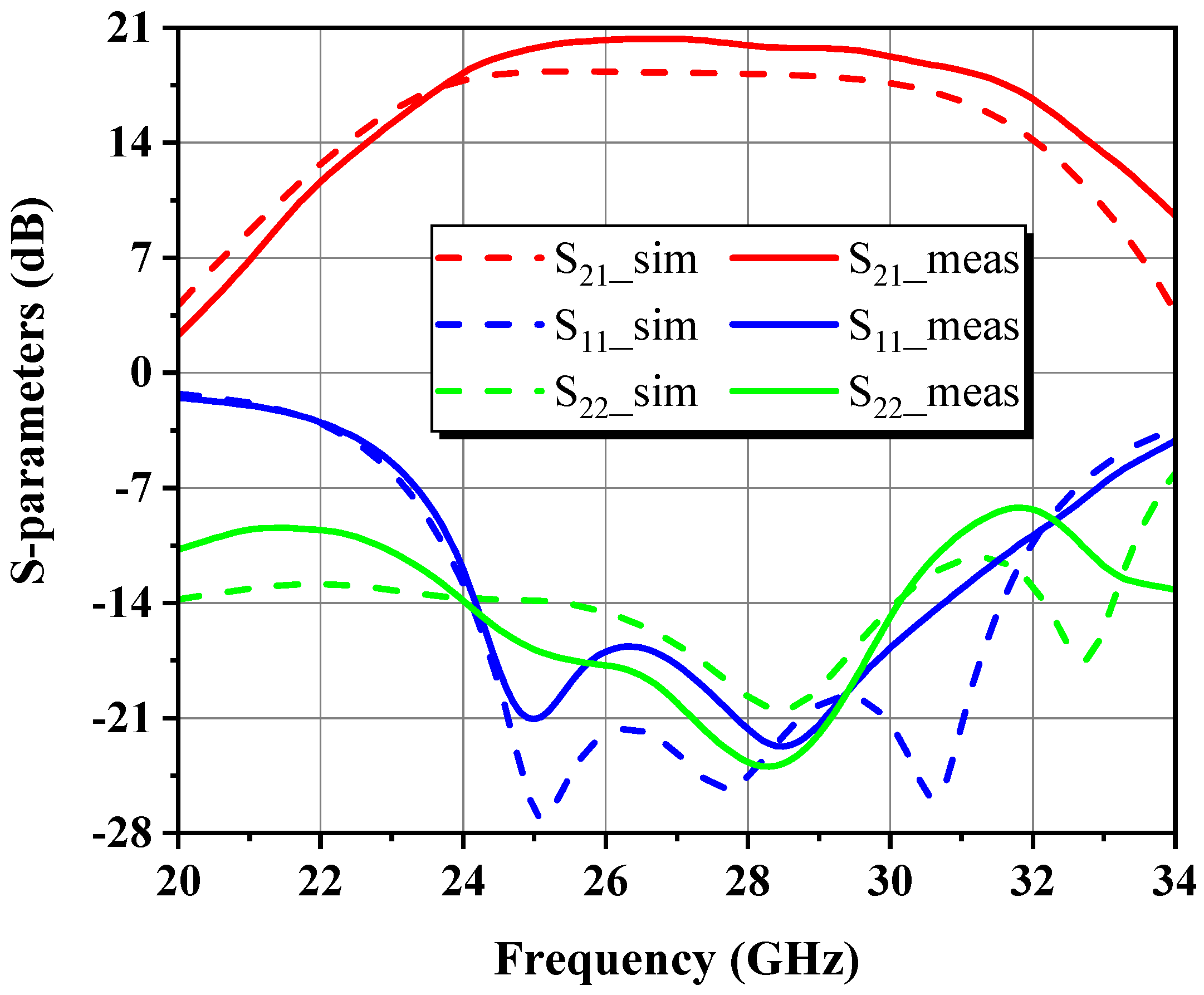
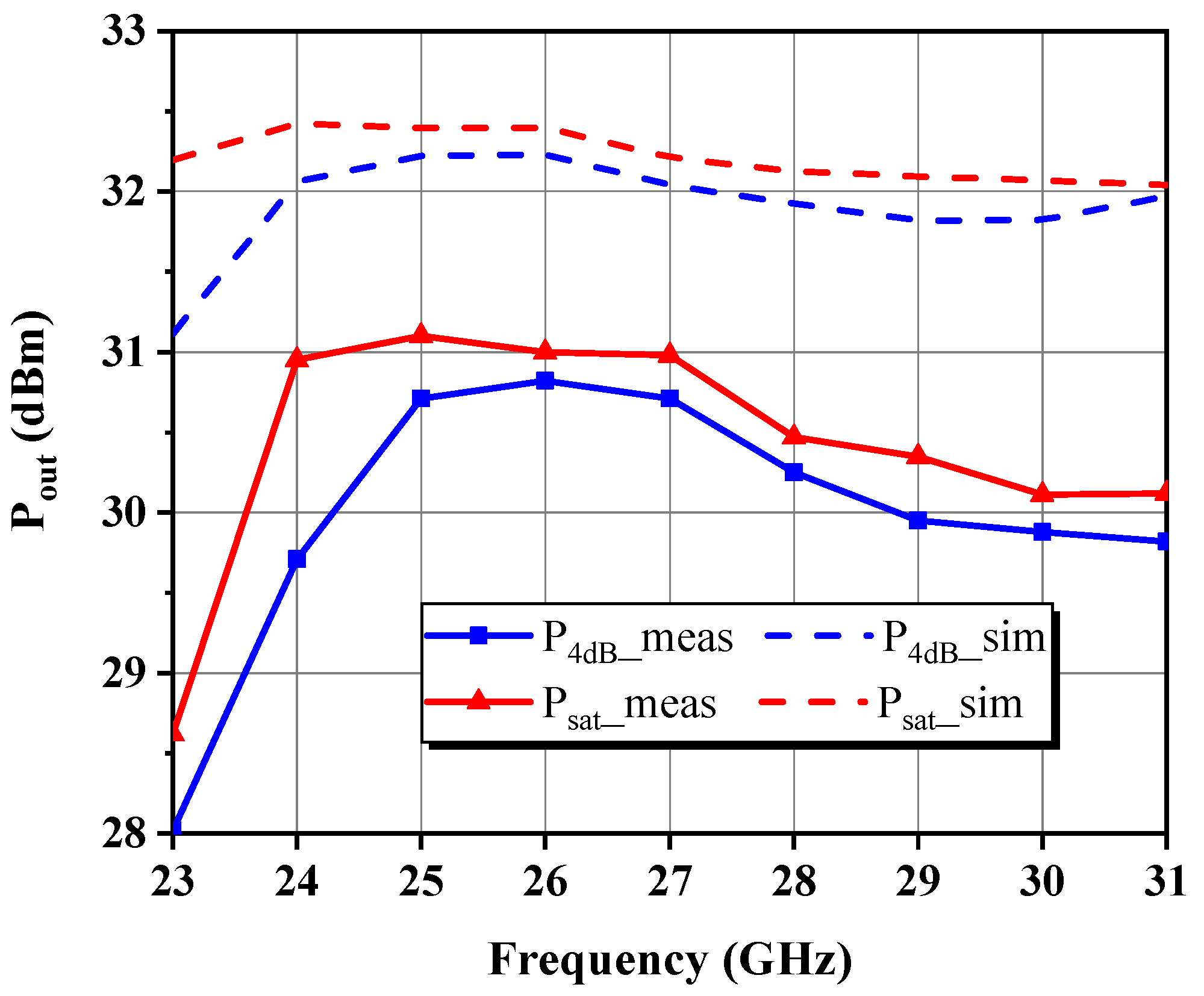

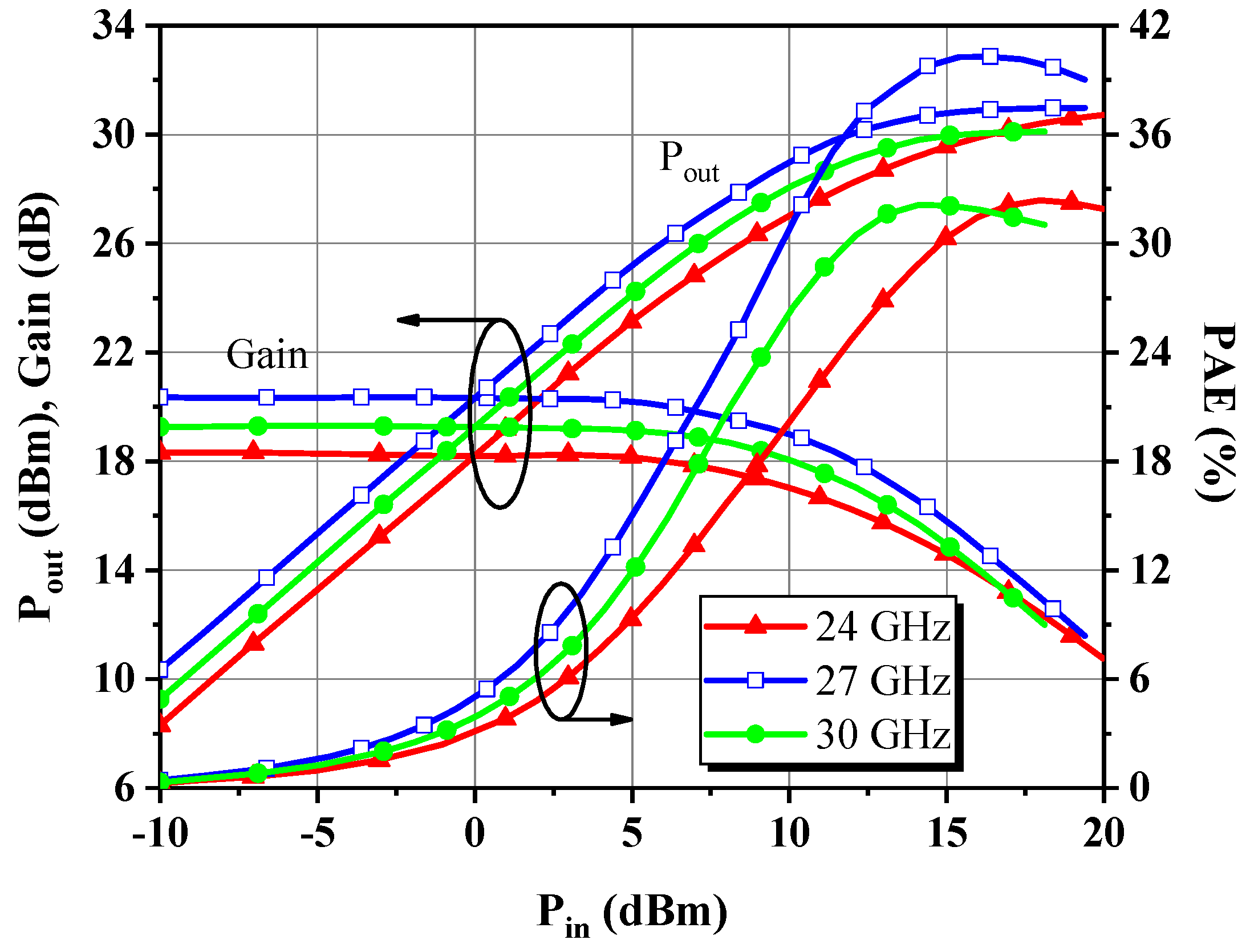
| Freq. (GHz) | ZL,opt (Ω) | ZS,opt (Ω) | ZS,fund (Ω) | PAEconv. (%) | PAEsimpl. (%) |
|---|---|---|---|---|---|
| 24 | 13.6 + j16.9 | 4.9 + j10.5 | 4.9 + j9.8 | 54.2 | 53.9 |
| 28 | 9.9 + j14.5 | 4.6 + j7.4 | 4.7 + j7.8 | 50.8 | 50.9 |
| 32 | 9.2 + j11.8 | 5.3 + j6.2 | 4.9 + j6.1 | 47.4 | 47.5 |
| Freq. (GHz) | P1 (Ω) | P2(Ω) | Pi (Ω) | Wi (%) | ZL,ctr (Ω) |
|---|---|---|---|---|---|
| 24 | 13.6 + j16.9 | 15.9 + j12.1 | 14.4 + j15.3 | 20 | 11 + j12.9 |
| 28 | 9.9 + j14.5 | 11.5 + j10.6 | 10.4 + j13.2 | 50 | |
| 32 | 9.2 + j11.8 | 10.4 + j8.5 | 9.6 + j10.7 | 30 |
| Freq. (GHz) | OMN | ISMN | IMN | |||
|---|---|---|---|---|---|---|
| ηmatch (%) | ηloss (%) | ηmatch (%) | ηloss (%) | ηmatch (%) | ηloss (%) | |
| 23 | 87 | 87.1 | 58.6 | 57.1 | 75.3 | 15.7 |
| 24 | 89.3 | 86.4 | 72 | 59.2 | 94.8 | 23.3 |
| 25 | 91.7 | 85.8 | 78 | 62.1 | 99.8 | 31.8 |
| 26 | 93.9 | 85.1 | 80.5 | 65.5 | 99.4 | 39.6 |
| 27 | 96.2 | 84.4 | 83.9 | 68.7 | 99.5 | 45.8 |
| 28 | 98.6 | 83.6 | 88.9 | 71.1 | 99.6 | 49.4 |
| 29 | 100 | 82.6 | 94.5 | 71.6 | 99 | 49.1 |
| 30 | 98.6 | 81.2 | 99.2 | 70 | 99.3 | 44.1 |
| 31 | 93.8 | 79 | 98.1 | 66.5 | 99.3 | 36.5 |
| Ref. | [2] | [17] | [18] | [19] | [20] | TGA2594 [29] | This Work |
|---|---|---|---|---|---|---|---|
| Process | 0.15 μm GaAs | 0.1 μm GaN/Si | 0.1 μm GaN/SiC | 0.15 μm GaN/SiC | 0.1 μm GaN/Si | 0.15 μm GaN/SiC | 0.1 μm GaN/Si |
| VD (V) | 5 | 12 | 15 | 20 | 12 | 20 | 12 |
| Meas. mode | CW | Pulsed | Pulsed | CW | Pulsed | CW | Pulsed |
| Freq. (GHz) (FBW) | 25–29 (14.8%) | 22–27 (20.4%) | 27–34 (23%) | 32–38 (17.1%) | 24–30 (22.2%) | 27–31 (13.8%) | 24–30 (22.2%) |
| Gain (dB) | 22.7 ± 0.7 | 24 ± 0.5 | 20.5 ± 1.5 | 17 ± 0.5 | 17.9 ± 1.5 | 23.6 ± 1.9 | 19.3 ± 1 |
| Pout (dBm) | 26 ± 0.3 | 31 ± 0.7 | 38.7 ± 0.4 | 36.7 ± 0.5 | 39.9 ± 1 | 37 ± 0.4 | 30.6 ± 0.5 |
| PAE (%) | 27.2–32.5 a | 30.5–36.9 b | 24.5–30.5 a | 25–34 c | 24–37 b | 26.5–30.3 c | 30.9–39.8 a |
| Size (mm2) | 2 × 1.3 | 1.8 × 0.87 | 4.5 × 3.5 | 2.22 × 1.6 | 3.7 × 3.2 | 3.24 × 1.74 | 1.65 × 0.78 |
Disclaimer/Publisher’s Note: The statements, opinions and data contained in all publications are solely those of the individual author(s) and contributor(s) and not of MDPI and/or the editor(s). MDPI and/or the editor(s) disclaim responsibility for any injury to people or property resulting from any ideas, methods, instructions or products referred to in the content. |
© 2023 by the authors. Licensee MDPI, Basel, Switzerland. This article is an open access article distributed under the terms and conditions of the Creative Commons Attribution (CC BY) license (https://creativecommons.org/licenses/by/4.0/).
Share and Cite
Peng, L.; Yan, J.; Zhang, Z.; Zhang, G. An Efficient 24–30 GHz GaN-on-Si Driver Amplifier Using Synthesized Matching Networks. Micromachines 2023, 14, 175. https://doi.org/10.3390/mi14010175
Peng L, Yan J, Zhang Z, Zhang G. An Efficient 24–30 GHz GaN-on-Si Driver Amplifier Using Synthesized Matching Networks. Micromachines. 2023; 14(1):175. https://doi.org/10.3390/mi14010175
Chicago/Turabian StylePeng, Lin, Jing Yan, Zhihao Zhang, and Gary Zhang. 2023. "An Efficient 24–30 GHz GaN-on-Si Driver Amplifier Using Synthesized Matching Networks" Micromachines 14, no. 1: 175. https://doi.org/10.3390/mi14010175
APA StylePeng, L., Yan, J., Zhang, Z., & Zhang, G. (2023). An Efficient 24–30 GHz GaN-on-Si Driver Amplifier Using Synthesized Matching Networks. Micromachines, 14(1), 175. https://doi.org/10.3390/mi14010175





